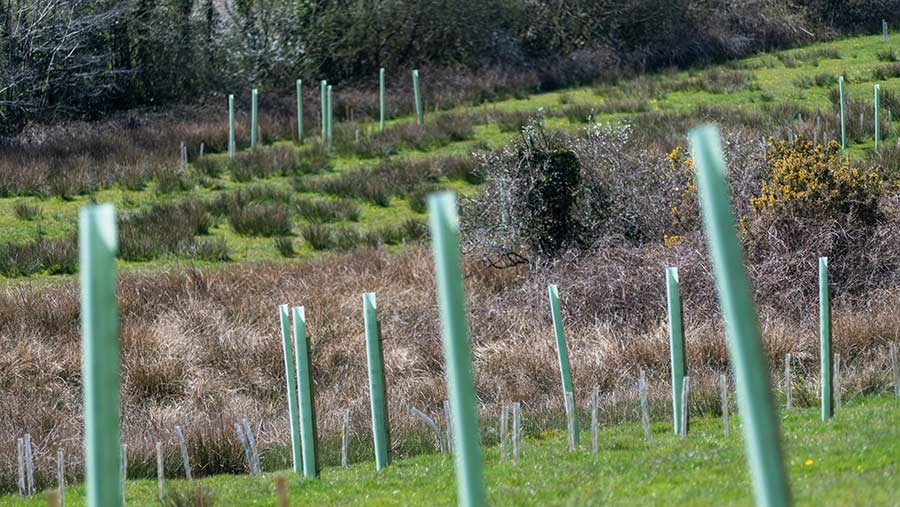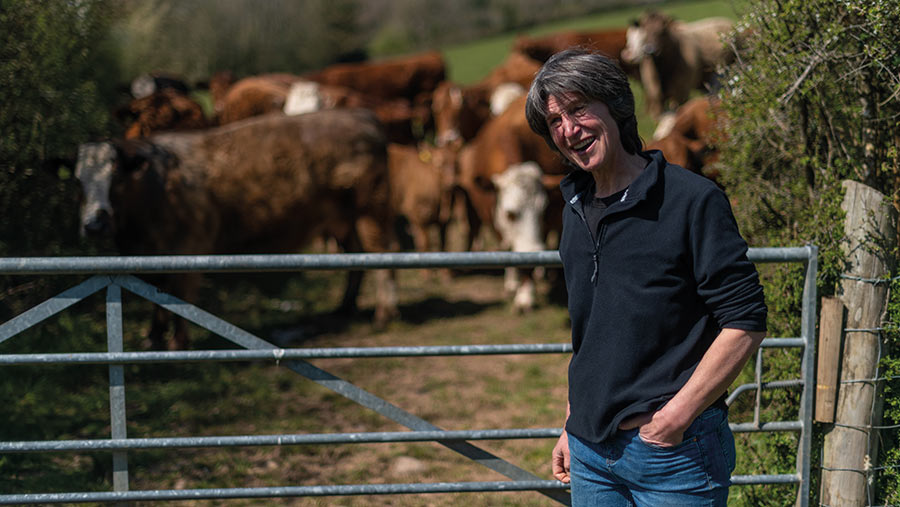Silvopasture: What it is and how it benefits livestock farming
 © Jim Wileman
© Jim Wileman Tree planting can make a valuable contribution to a range of public goods, such as carbon sequestration, improved soil health, increased biodiversity, water quality and flood mitigation, all of which are under scrutiny on UK farms.
However, little research has been done to quantify the benefits of planting more trees on farms, or how to incorporate trees to maintain or improve farm productivity.
See also: Finalists line up for 2020 Nuffield Bullock award
A recently launched farmer-led project in Devon aims to provide the answers, investigating whether silvopasture, the practice of integrating trees and livestock, is a viable way of addressing climate and nature concerns while meeting the needs of farmers.
The trial, led through Innovative Farmers, a not-for-profit network for producers carrying out on-farm trials, is partnered by the Woodland Trust, FWAG South West, Rothamsted Research North Wyke and the Organic Research Centre.
Rebecca Swinn, network co-ordinator at Innovative Farmers, says: “With the climate crisis upon us, many farmers recognise the need to adapt and innovate.
“We think silvopasture will be a key element of farming, but we need robust studies to assess its impact on a range of environmental measures as well as sward productivity and diversity and the wellbeing and productivity of livestock.
“Co-designing the project with farmers is key to ensuring we gather all the evidence and share it as widely as possible to promote widespread adoption.”
Silvopasture concepts
Three tree planting designs to suit a range of grazing needs are being assessed in the 12-year Devon trial, which involves seven farms.
Living barns
Living barns are similar to shelterbelts that livestock can access. These contain taller trees that reduce exposure to the elements and lower trees and shrubs that offer additional nutrition.
Potential benefits:
- Extension of grazing season
- Reduction in lamb mortality
- Additional nutritional benefits
- Increased biodiversity, improved soil health, carbon sequestration.
Potential drawbacks:
- Loss of grazing during establishment – typically 20%
- Potential loss of BPS payments in shelter belt areas
- Restricted grass growth in shelter belts.
Regular spacing
Regularly spaced trees and shrubs (often alleys) provide dappled shade and scattered shelter for animals across the entire grazed area without restricting access to machinery.
The area between strips provides a paddock system that can be mob grazed, increasing sward productivity. Once established, fencing runs through strips so paddocks incorporate pasture and trees.
Potential benefits:
- Shade allows livestock to graze during hot days
- Alternative nutrition for livestock, self-medication
- Most of field is productive grassland; limited impact on yield
- Provision of in-field wildlife habitats
- Compatible with continued BPS payments during establishment.
Potential drawbacks:
- Fewest biodiversity benefits of the three designs
- Can require significant amounts of electric fencing to protect tree rows if grazed through establishment.
Open grazed clustered wood pasture
This mix of open pasture and dense clusters of shrubs and trees mimics natural regenerated wood pastures. About 75% of the pasture is left open.
Potential benefits:
- Shelter for livestock
- Animals graze on tree- and pasture-based fodder
- Shrubs provide good browsing access
- Creates attractive landscape and good wildlife habitats
- Can over-winter dry cows and young stock.
Potential drawbacks:
- Grass in clusters cannot be regularly grazed until trees can withstand livestock rubbing
- Potential loss of BPS payments through establishment period
- Intermittent sheep grazing or cutting for hay could retain agricultural activity.
Agroforestry grants
About 70% of UK land is farmed, but only 3% of that practises agroforestry. However, Helen Chesshire, lead farming advocate for the Woodland Trust, believes this could soon change.
“We have been working in this area since 2012 and I’ve noticed a real growth in interest,” she says. “Many farmers are now thinking trees have a role to play in improving their farming businesses.”
The trust operates a small-scale bespoke scheme, Trees for your Farm, funded by Sainsbury’s and the PUR Project, which enables farmers to pilot agroforestry schemes.
These cover tree and tree protection costs, with a typical upper limit of 4,000 trees.
The three designs in the Devon silvopasture project typically cost about £1,750-£2,000/ha including the cost of trees, protection, fencing and labour.
Costs will vary, but it seems clear that further grant funding will be needed to encourage wider uptake.
The Woodland Trust is part of a Defra test for agroforestry within the Environmental Land Management scheme (ELM), examining payment incentives and advice farmers would need to take up agroforestry at scale.
Agroforestry in ELM
“Feedback from Defra suggests agroforestry should be part of the ELM scheme,” says Mrs Chesshire.
“We are working constantly to ensure it will feature in the Sustainable Farming Incentive and Local Nature Recovery, but there is still a way to go and this project will provide valuable knowledge.”
Luke Dale-Harris, farm adviser at FWAG South West, which initiated and co-ordinates the trials, is also positive.
“It seems increasingly likely that Environmental Land Mmanagement schemes will reward agroforestry in some shape or form,” he says.
“Farmer interest is growing and we are encouraging farmers to think about agroforestry and how it can fit with their wider farm plans.
“Silvopasture systems need to be correctly designed to address specific farm challenges, while allowing for changes in land use and management as time goes on.”
There is plenty of advice available from FWAG, The Woodland Trust, pilot farmers, webinars and publications such as the Soil Association’s Agroforestry Handbook to help farmers prepare, he adds.
For more information on planting designs see the Innovative Farmers website.
See the Webinar: The right trees in the right places.
Silvopasture trial on West Emlett Farm

Hen Curtis © Jim Wileman
Devon farmer Hen Curtis is trialling all three designs at West Emlett Farm, near Crediton, Devon, which she runs in partnership with her husband.
The 100ha organic unit produces suckler beef and finished lambs as well as oats for human consumption.
“One reason for joining the trial is to promote a low-input, high-welfare farming system that benefits the environment,” says Mrs Curtis.
“And there is so much negativity around meat production at the moment, with very little distinction between production systems. Even though we are organic producers we feel the pressure is on.
“I think the trial will help us find ways of becoming carbon neutral. We need to convince ourselves and others that meat production does not have to be bad for the environment – having scientists involved may help.”
The main challenge is that silvopasture must complement the farm system.
Tree planting started in February this year and Mrs Curtis suspects living barns will be most beneficial for the farm and the easiest design to integrate.
A 4ha exposed field was chosen for this design, which will provide shade and shelter for animals while allowing rotational grazing.
“We divided the field into four 1ha areas, so we can graze it more efficiently. Stock will also be able to browse in the trees, accessing minerals that can be lacking.”
Each belt of trees is 12m wide, occupying about 20% of the field.
Larger trees such as oak, scots pine and aspen occupy the middle, surrounded by protective hawthorn shrubs, with faster growing alder and birch either side. Clusters of shrubs make up the perimeter.
A further 1.15ha of permanent pasture has been planted with the open grazed clustered wood pasture, where clumps of standard trees are dotted around the field, protected by thorns and shrubs.
“We are adding more trees and shrubs to fit into an already attractive, but less productive, area, so loss of grazing during the establishment phase will have less of an impact,” says Mrs Curtis.
Regular spacing is being trialled on about 1ha of more productive pasture. “The strips are about 7m wide and trees are set 7m apart, which will give us enough room to farm between them,” says Mrs Curtis.
“This design is probably the most productive for grass, but whether it will be as useful as living barns remains to be seen.”
The living barn design cost about £8,400 to establish, just under £2,000/ha. “The Woodland Trust provided the trees and materials, we supplied the labour,” says Mrs Curtis.
“It’s early days of course, but I suspect that amount might be difficult to recoup from increased productivity.
“But, if the trial demonstrates positive environmental benefits we may be able to access payments that would make it worthwhile and encourage wider uptake.
“Hopefully all the designs will be beneficial – it will be interesting to see how they are all going to work.”
Living barns cost: West Emlett Farm |
|
|
Item |
Unit |
|
Area of field (ha) |
4.23 |
|
Area of belts (ha) |
0.85 |
|
Number of trees |
846 |
|
Number of thorns |
1269 |
|
Fence length (m) |
1163 |
|
Cost of trees |
£2597.22 |
|
Cost of thorns |
£761.40 |
|
Cost of fence |
£5815.00 |
|
Total |
£8,412.22 |
Thanks to Woodland Trust, whose sponsorship made it possible for us to run this article. Farmers Weekly had full editorial control of its content.
Woodland Trust MOREwoods scheme

Trees should be in every farmer’s toolbox. They boost productivity, resilience and the health of the environment – with no need to trade off with production. Make your planting project a success with the Woodland Trust’s MOREwoods scheme, funded by Lloyds Bank.
Plant at least 0.5ha and we could cover up to 75% of costs. An expert will visit to discuss the best options for your business and if eligible, arrange tree delivery and protection.
All trees are sourced and grown in the UK and Ireland. No obligation advice is available even if you decide not to plant.
